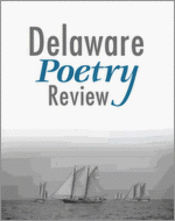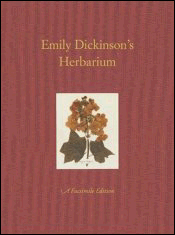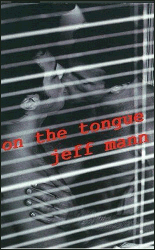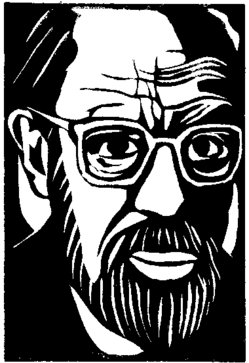The ever stunning Regie Cabico on Def Poetry Jam…
He’s announced as being from Williamsburg but Cabico now lives in Washington, DC. A great poem. A lot of fun and moving too.
The ever stunning Regie Cabico on Def Poetry Jam…
He’s announced as being from Williamsburg but Cabico now lives in Washington, DC. A great poem. A lot of fun and moving too.
if your luck goes bad
get a witch to give you
a bath
get a shaman to cook
your supper
get a high priestess
to do your hair
get a siren to sing you
a lullaby
all ritual is illogical
and impractical
but when it works
the absurd
becomes
the sublimeFranklin Abbott
1,2 August 2007
Stone Mountain
When I travel to see my friends Alejandro and Alex in central Venezuela it isn’t long before Alex
gives me a ritual cleansing bath.
Alex is a brujo, or witch, who works with nature spirits. I am bathed under the huge mamones tree in their back garden.
Alex concocts my bathing solutions from various ingredients as common as vinegar and as rare as an herb from some remote valley.
The process can take several hours and culminates when Alex draws magical designs in gunpowder around me and then ignites them.
Poof pow be gone! and whatever cosmic crud I had accumulated in my aura is dispersed.
For me the most sacred place in the home is the kitchen.
True magic can be made on the altar of the stove. The four elements of earth, air, fire and water all comingle and their alchemy produces the sweet and salty tastes we all swoon over.
The High Priestess is one of the archetypal figures of the Major Arcana of the Tarot. Her power is the power of Great Mystery. In her spare time she rearranges the galaxies.
The Sirens were mythical beings who lured sailors to their doom with their ethereal haunting songs.
We use their name for the sounds made by ambulances and police cars.
We also bestow the title on those voices whose songs make us weak in the knees.
the Red Cross
won’t take
my blood
but mosquitoes
will
why are they
so hard
to kill
they orbit
earth
differently
so much
I rarely
catch
them
when I do
it is an
old mosquito
about to be
sent to
assisted living
that gives
itself up
to my clap
in that rare
instant when
I win
a million more
are born
and I
begin againbuzzzzzzz
Franklin Abbott
22 July 2007
Stone Mountain
The Red Cross will not accept blood from men who are or have ever been sexually active with other men, a point of controversy in the gay community. Only female mosquitoes are blood suckers. Males dine on flower nectar.
Mosquitoes do have flight patterns that confuse us. They evolved long before we did.
In old Japan mosquitoes were thought to be Preta, souls of people whose misdeeds in former
lives reincarnated them as blood suckers. Given the number of mosquitoes in my back yard alone
there must be lots of wicked humans in past generations.
Buzzzzzz, here comes one now.
 I’m doing this because Dan, who is, I believe, immoderately modest, won’t.
I’m doing this because Dan, who is, I believe, immoderately modest, won’t.
Dan, who so ably and beautifully conspires with me to realize this idea he and I share called White Crane, is also a poet of the D.C. variety, and has two poems recently published in the Delaware Poetry Review.
One of them is a particular favorite of mine…Emily Dickinson At the Poetry Slam because I love Emily Dickenson…and because I love Dan.
And please, visit his website to see more…
the only person
I know who ever
contemplated
poisoning me
is my friend
Takafumi
I was his guest
at a fancy restaurant
in Osaka
when he ordered for us
the most expensive dish
on the menu
an appetizer
of fried fugu fish
without telling me
in my memory
he continues
with chop sticks
dips in soy sauce
takes the first
bite of heaven
and offers me
the next
Franklin Abbott
13 July 2007
Stone Mountain
 Book Reviews
Book Reviews
Emily Dickinson’s Herbarium:
A Facsimile Edition
The Belknap Press, Harvard University
Cambridge, MA and London, 2006
Reviewed by Kim Roberts
The Herbarium was the first book Dickinson ever made. She began it around age 13, while a student at Amherst Academy, and enamored of her classes in Botany. Ironic then, that this should be the last of her books to become available to the public. But the Herbarium is so fragile that it has been displayed to the public only once. It is only now, with improvements in high-resolution digital color imagery, that such a facsimile edition as this was possible.
And it is gorgeous: the large format reproductions almost give us the sense of holding the actual book, each page captured lushly, the specimens affixed to the pages and carefully labeled with the flowers’ scientific name, and a set of numbers identifying the class and genus according to the old Linnean system of classification (which became outmoded even during Dickinson’s life). The Herbarium contains 424 specimens in 66 pages, almost all identified by the poet, and most of her identifications are correct. She artistically arranged between two and eleven specimens to a page, combining native species from around Amherst, Massachusetts with specimens of garden and house plants.
Dickinson studied Botany beginning at age nine, and kept both her Herbarium and her Botany textbook throughout her life. That early text, by Almira Hart Lincoln, touted the study of Botany as the science most suited for female students since "the objects of its investigation are beautiful and delicate; its pursuits, leading to exercise in the open air, are conducive to health and cheerfulness."
Dickinson began this project in a fashionable spirit; she wrote to her friend Abiah Root at age 14: "Have you made an herbarium yet? I hope you will if you have not, it would be such a treasure to you; ‘most all the girls are making one." Dickinson included in that letter a geranium leaf for Abiah to press.
From this point on, Dickinson enclosed flowers in a number of letters, entering into a female tradition of gift exchange. Probably some specimens in her Herbarium were prepared by friends, and had personal associations for the poet at which we can only guess. Dickinson’s practice, later in life, of enclosing poems in letters (many of which were on the subject of flowers) can be seen as a continuation of this exchange; the poems are blossoms transformed, carrying their own symbolic weight.
The language of flowers, now largely lost to contemporary readers, was a common woman’s idiom in Dickinson’s time. Different species were thought to convey particular moods or situations. Giving flowers was thus also sending messages—of devotion, mourning, gratitude, or purity, for example. In the only daguerreotype of the poet, she holds a sprig of flowers in her hands; I have always wondered what kind, but the photo is not detailed enough to reveal its secrets.
We know that Dickinson was an avid collector; tramping alone through the woods surrounding Amherst, or in the company of her sister Lavinia, she wandered freely. The Herbarium represents, then, Dickinson’s formative years, when she was learning to look closely at nature, before she chose for herself a more restricted adulthood. She referred to this earlier time as her "boyhood." (In her poem, "A narrow fellow in the grass," her poem about encountering a snake, she wrote: "Yet when a Boy, and Barefoot—/I more than once at Noon//Have passed, I thought, a Whip lash/Unbraiding in the Sun.")
Though the flowers have faded, the Herbarium retains its beauty. I can’t help but marvel: here is the evening primrose, whose petals are nearly transparent; the musk mallow whose bloom turns coyly to one side, as if shy; the large iris that retains a hint of its original blue; the thick-stemmed pitcher plant; the beautiful S-curve of the trout lily’s stem, preserved; the flowers of the arrowhead placed by Dickinson atop the broad chevron of its leaf; the surprising inclusion of both tobacco and marijuana.
Here also: the blooms of the foxglove, arrayed along the line of its stem, faded from pink to pale sepia; the sweet-scented water lily haloed by the thick circle of its leaf, so it looks like it is wearing a ruff; the tulip, its petals split apart to show off its stamen; the dogwood, with the intricate lace of lines in each petal; the amorphous blob of delicate green shoots from the smoketree; the berries still clinging to the eastern red cedar; the five-pointed star of the toad cactus flower.
Some specimens cannot help but remind me of poems Dickinson would later write: the arbutus, which she would immortalize in her poem "Pink — small — and punctual"; the two oxeye daisies, their stems carefully crossed on the book’s pages, which bring to mind her own identification with this flower ("How modestly — always — /Thy Daisy— /Draped for thee!"); or the lilac, all its purple now leached away ("The Lilac is an ancient shrub"). She included a full page of violets: palmate, downy yellow, birdfoot, round-leafed, and sweet white. This flower would later appear in poems too ("The Love of Thee–a Prism be—/Excelling Violet—").
The Indian Pipe has been damaged: the black stem remains, but the ghostly white flower is gone. Is this some unintended metaphor? Mabel Todd Loomis (who would posthumously edit Dickinson’s work) mailed her a small painting of this plant, which Dickinson called "the preferred flower of life" and "an unearthly booty." Loomis later reprinted the painting on the title page of Dickinson’s first edition of poems.
Dickinson’s Herbarium also includes some rare species, such as the strawberry blite and the gentian. The latter would appear in several poems, and must have seemed particularly evocative to the poet, not only for its rarity but because it bloomed so late in the season. The fringed gentian inspired one of my personal favorites of Dickinson’s poems:
God made a little Gentian—
It tried — to be a Rose—
And failed— and all the Summer laughed—
But just before the Snows
There rose a Purple Creature —
That ravished all the Hill —
And Summer hid her Forehead —
And Mockery — was still —
The Frosts were her condition—
The Tyrian would not come
Until the North — invoke it —
Creator — Shall I — bloom?
But as sweet as the rare specimens are, I was pleased to find as well the most ordinary and mundane flowers in the Herbarium. She collected wood sorrel ("The Clover’s simple Fame/Remembered of the Cow— ") as well as the common dandelion, signal of Spring:
The Dandelion’s pallid tube
Astonishes the Grass,
And Winter instantly becomes
An infinite Alas—
The tube uplifts a signal Bud
And then a shouting Flower,–
The Proclamation of the Suns
That sepulture is o’er.
The Herbarium must be seen as the poet’s birth — looking at these pages, we cannot help but make the connection. Dickinson would later translate the collecting of flower specimens into bouquets of poems, bound together in hand-sewn small books.
Richard B. Sewall’s excellent prefatory essay places the Herbarium in this context. He writes that this first book "foreshadowed much of what was to come…in the care she took in the herbarium, in the precise botanical knowledge it displays, in the fine composition of every page, the bent of her nature is clear: she was a ‘maker’ from the beginning." The facsimile edition also contains a Forward and Preface, and Ray Angelo’s extremely useful "Catalog of Plant Specimens."
This is just an excerpt from this issue of White Crane. We are a reader-supported journal and need you to subscribe to keep this conversation going. So to read more from this wonderful issue SUBSCRIBE to White Crane. Thanks!
Kim Roberts is a poet and community activist living in Washington, DC. Her most recent book of poems, The Kimnama was released by VRZHU Press this Spring.
 Book Review
Book Review
On the Tongue
Poems by Jeff Mann
Gival Press, 94 pages, $15.00
ISBN-10: 1928589359
Reviewed by Dan Vera
Readers of Jeff Mann’s last book, his part memoir/part poetry book Loving Mountains, Loving Men have cause for great celebration. If you were enraptured by his prose writing, with the way it revealed Mann’s generous heart, yet felt you wanted more of his distilled poetic voice, his new book will put a huge grin on your face.
Mann, who teaches at Virginia Tech and won the 2007 Lambda Literary Award for his History of Barbed Wire, has here produced a work of such open-hearted capability. Many of these poems are just staggeringly good. In his capable and goodly hands, the scarred arm of a bartender becomes a thing of beauty and the act of loving becomes the union of tree and earth.
One of the assuring blurbs in this book calls Mann the “Sappho of Appalachia.” High praise indeed, but with Sappho we are left with small fragments. Mann’s work is fully, pleasurably revealed on the page. There is no guessing left to the eye or mind and the reader is allowed to join him in celebrating the enduring beauty of the male form. Reading Mann’s naturalistic evocations of the body of the beloved put me to mind of Pablo Neruda’s swelling love poetry in his Captain’s Verses or Audre Lorde’s sultry lover poems. These are clear, direct gazes at the lover that become meditations on the merging of human bodies as elemental, geological, and seismic encounters.
This book is nothing less than a breakthrough. I found myself feeling pride at reading such a masterful collection of gay poems, at the sense that we’d finally reached a moment where our poets could write the truth that has so long been withheld. Two centuries ago, one of our proto-gay forebears, Karl Heinrich Ulrichs, argued that gay love is natural because it exists in nature. For Mann, it is nature itself.
Sup these poems.
This is just an excerpt from this issue of White Crane. We are a reader-supported journal and need you to subscribe to keep this conversation going. So to read more from this wonderful issue SUBSCRIBE to White Crane. Thanks!
Dan Vera is managing editor of White Crane. A poet and writer in Washington, DC, he can be reached via dan@gaywisdom.org or at www.danvera.com
This is such a darling little video about a guy’s love of Mark Doty. It’s part of the American Academy of Poets’ Poetfan program.
T.S. Eliot’s "The Love Song of J. Alfred Prufrock" read by the great English actor Michael Gough.
 Poetics and Consciousness
Poetics and Consciousness
Or Why Howl Still Matters Fifty Years Later
by David Carter
In August of 1955 a young gay writer in San Francisco sat down at his typewriter, stuck in some scratch paper, and began to improvise on a single line he had scribbled in his journal about ten days prior. He was determined to just start writing what he was feeling without worrying about how it would sound to anyone who read it. He wrote primarily for himself, for his own pleasure, although as he warmed up to his task he began to have in mind a writer friend who might enjoy his new creation, for the friend had told the young man not to worry about his abilities but to just get into a rhythm and keep going with it and trust himself.
To trust himself. To let go.
That was how the young man had tried to live and had largely done just that since his first year at Columbia University when a friend by the name of Lucien in his dormitory who read Rimbaud had introduced him to two other friends of his named Jack and William he thought the sensitive and literary young man would find interesting. To describe Jack Kerouac and William Burroughs as interesting was understatement, as the two friends gave Allen Ginsberg a fast education in literature and life. In a period of conformity and repression, the three friends sought a new consciousness. Burroughs pointed to William Blake as a possible alternative model to contemporary values, and Ginsberg had a vision of Blake’s poetry that, while transcendent, pointed to the earth and our physical surroundings as the ground for that transcendence. Young Allen showed literary promise and Kerouac praised his writing, while urging Ginsberg to push it further.
But while Allen had found his calling in poetry, his life had also become a series of disasters and traumas. His friend Lucien Carr had killed a friend of Allen’s who had become obsessed with Carr, and had stabbed him twice through the heart. Tortured by his homosexual feelings and tremendous longing, Ginsberg had been thrown out of Columbia University after Kerouac had come over to visit and ended up staying the night. The youth’s schizophrenic mother had been institutionalized. She had been throwing herself into walls so violently that the psychiatrists who cared for her were afraid she would seriously injure herself and so had requested Allen to authorize a lobotomy. He had done so and felt guilty about it. Bill had introduced Allen and Jack to Herbert Huncke, a Times Square hustler who was also a junkie. When Huncke had shown up years later at Allen’s door at a low point in his life, Allen had taken him in. Herbert started stealing and stashed the loot in Allen’s apartment, and Allen had been arrested and only missed going to jail by agreeing to undergo psychiatric treatment. The psychiatrists told Allen that he should reject Huncke and Burroughs. He met another new friend, Neal Cassady, who was wild about literature and Allen fell deeply in love with him. When he finally found the courage to confess his homosexuality to his father, he concluded that Allen was going crazy and told him that he should not see Neal. Then Burroughs accidentally shot his wife in the head, killing her. Ginsberg wrote anguished letters expressing the terrible anxiety these and other experiences put him through.
As the pressures built on him, not only Kerouac, Carr, and Burroughs were afraid that Allen might go insane but so was William Carlos Williams, the New Jersey poet who had tried to help and encourage the young Ginsberg. And so in 1954 Allen Ginsberg moved to San Francisco and determined to make a go at “normal” life.
He got a job doing market research for an ad firm and was successful enough to have two secretaries and a nice apartment on fashionable Nob Hill. He met a woman and got involved in his first serious heterosexual affair. The “straight” life seemed good at first and Ginsberg decided that he wanted to get married, have kids, and continue to work in advertising. But it was not long after starting the routine job and becoming involved with a woman that he found that he was depressed. One night, walking the city streets after ingesting peyote, he looked at the Sir Francis Drake Hotel, which seemed to take on the aspect of an inhuman monster, robotic in its cold impersonality. In November, 1954, the month after the vision of the city as a modern Moloch, he re-entered therapy. The next month he met a youth he became smitten with, Peter Orlovsky.
A few months later the young therapist he was seeing asked Allen what it was he really wanted to do? Allen replied that he wanted to quit his job, write poetry, and move in with Peter. This therapist did not try to make him abandon his dreams but instead asked him, “Well, why don’t you?” It was a total revelation to the youth.
By February of 1955 Peter and Allen started living together. By May, Allen had managed to get laid off from his job so that he could collect unemployment. That summer he completed some new poems and sent them to Kenneth Rexroth, the dean of San Francisco poets. Rexroth didn’t care for the poems and wrote back to Ginsberg, “Do something original.” It was only a few weeks later that Allen Ginsberg rolled the scratch paper into his typewriter and began to write the poem that would change poetry forever. It made Allen Ginsberg famous, enabled him to get his friends’ works published and launched the artistic, social and consciousness movement known as the Beats, and thereby laid much of the foundation for the 1960s and all that grew out of that turbulent, creative decade.
That one poem and one poet could ultimately bring about so much change directly and indirectly would be an amazing thing in and of itself. What is more wonderful, however, is how simple the essential ideas were that found expression in the Beat writers.
But if the ideas were simple, the road to finding them had been complex, both for the young men who were the beneficiaries of these insights as well as for the older theoreticians and poets who worked hard to arrive at those theories and insights in the first place. What is perhaps most amazing is that the ideas were not merely simple, they were almost beyond simplicity: breathe naturally, listen to the sounds and rhythms of words and human speech; pay attention to the tone leading or length of vowels.
This is just an excerpt from this issue of White Crane. We are a reader-supported journal and need you to subscribe to keep this conversation going. So to read more from this wonderful issue SUBSCRIBE to White Crane. Thanks!
David Carter is the author of Stonewall: The Riots That Sparked the Gay Revolution and editor of Spontaneous Mind: Selected Interviews with Allen Ginsberg. He lives in the West Village in NYC.
Woodcut of Allen Ginsberg by Justin Kempton — more portraits of progressive writers available at www.writersmugs.com